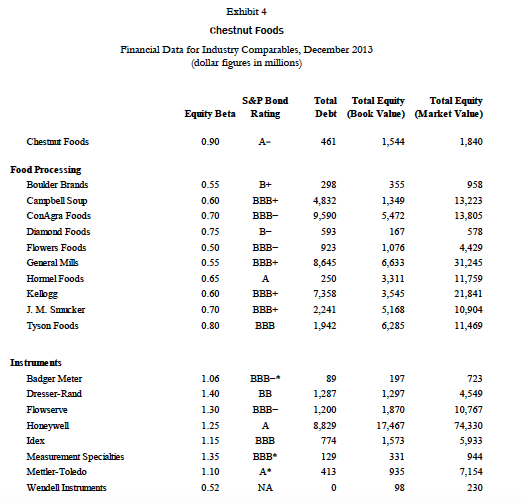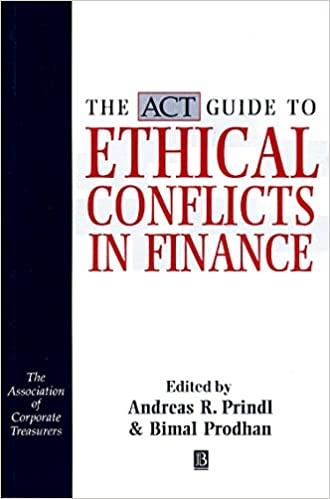Answered step by step
Verified Expert Solution
Question
1 Approved Answer
3. Estimate a risk adjusted cost of capital for the two business units and comment on whether Meyers graph is accurate (case Figure 1). In
3. Estimate a risk adjusted cost of capital for the two business units and comment on whether Meyers graph is accurate (case Figure 1). In estimating the cost of capital, consider the WACC estimates based on the comparable companies.
4. Calculate the EVA of Chestnuts divisions using a constant WACC and the divisional risk-adjusted WACC. How does the choice of a constant versus risk-adjusted hurdle rate affect the EVAof Chestnuts two divisions?


Chestnut Foods of WACC for Chestnut Foods (year-end 2013 Chestnut Foods Hurdle Rate as of December 2013: 7.0% Chestnut uses a hurdle rate that reflects prevailing rates of retum in financial markets using a weighted average of both debt and equity securities. The current mix of debt and equity in Chestnut's capital structure on a market-value basis is 20% debt and 80% equity. The prevailing yield on debt of similar credit risk is estimated at 3.5%. Based on a marginal corporate tax rate of 37%, the after-tax cost of debt is 2.2%. The cost of equity for Chestnut is estimated at 8.2% based on the CAPM with a beta of 0.9, a market risk premium of 6.0%, and a risk-free rate of 2.8%. Based on these estimates, the WACC is 7.0%. An alternative model that uses market risk premium of 9% andansk-free rate of 01%gives a similar cost-of-quity estimat Exhibit 3 Chestnut Foods Capital Market Data, December 2013 Yield 30-Day Treasury Bill 0.1% 10-Year Treasury Bond 2.8% 10 Year Corporate Bonds of Industrial Companies 2.8% 2.9% 3.2% 3.3% 3.5% BBB+ 3.8% 4.1% 4.6% 5.8% 6.5% 6.5% B+ 6.8% 9.0% Historical Market Risk Premium (Equity Market Index De 6.0% Data source: BNoomberg, case writer estimates. Chestnut Foods of WACC for Chestnut Foods (year-end 2013 Chestnut Foods Hurdle Rate as of December 2013: 7.0% Chestnut uses a hurdle rate that reflects prevailing rates of retum in financial markets using a weighted average of both debt and equity securities. The current mix of debt and equity in Chestnut's capital structure on a market-value basis is 20% debt and 80% equity. The prevailing yield on debt of similar credit risk is estimated at 3.5%. Based on a marginal corporate tax rate of 37%, the after-tax cost of debt is 2.2%. The cost of equity for Chestnut is estimated at 8.2% based on the CAPM with a beta of 0.9, a market risk premium of 6.0%, and a risk-free rate of 2.8%. Based on these estimates, the WACC is 7.0%. An alternative model that uses market risk premium of 9% andansk-free rate of 01%gives a similar cost-of-quity estimat Exhibit 3 Chestnut Foods Capital Market Data, December 2013 Yield 30-Day Treasury Bill 0.1% 10-Year Treasury Bond 2.8% 10 Year Corporate Bonds of Industrial Companies 2.8% 2.9% 3.2% 3.3% 3.5% BBB+ 3.8% 4.1% 4.6% 5.8% 6.5% 6.5% B+ 6.8% 9.0% Historical Market Risk Premium (Equity Market Index De 6.0% Data source: BNoomberg, case writer estimates
Step by Step Solution
There are 3 Steps involved in it
Step: 1

Get Instant Access to Expert-Tailored Solutions
See step-by-step solutions with expert insights and AI powered tools for academic success
Step: 2

Step: 3

Ace Your Homework with AI
Get the answers you need in no time with our AI-driven, step-by-step assistance
Get Started


